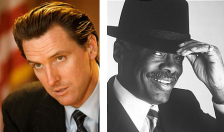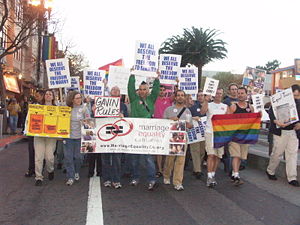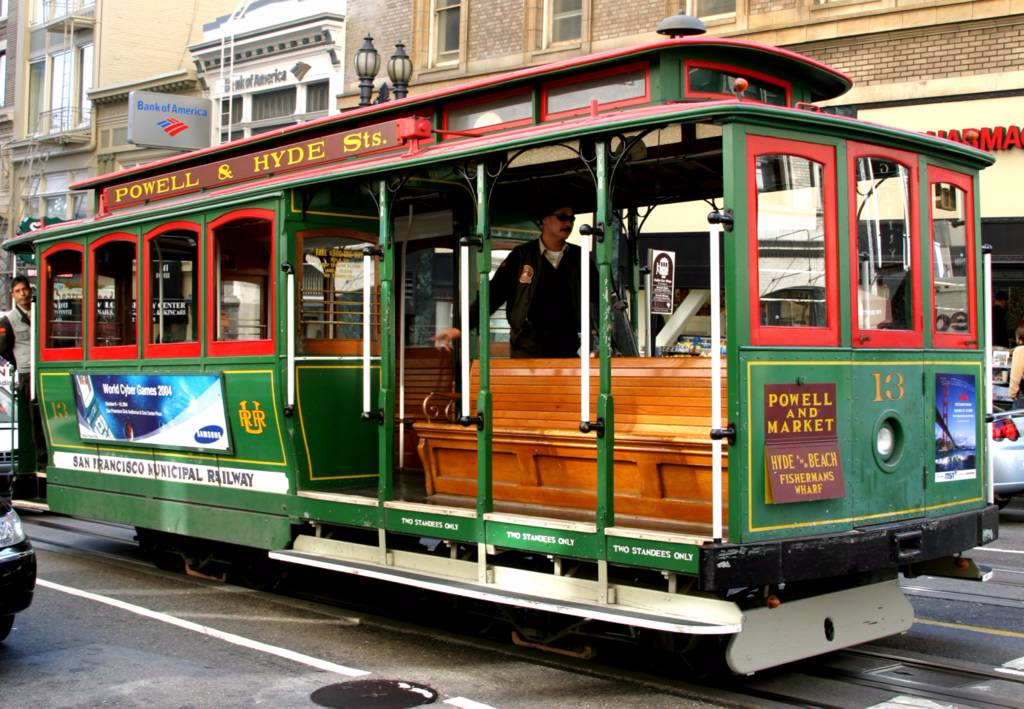San Francisco Bay Guardian, 2002-10-16, v37-n03 - 03wired
Former mayor Dianne Feinstein and current mayor Willie Brown are longtime PG&E allies. After vowing to support public power, former mayor Art Agnow (below) caved in to the company once in office. He now says he made a mistake and supported both public power measures last fall.
GUARDIAN ILLUSTRATION BY GEORGE RIEMANN FROM 5/7/97 ISSUE
How PG&E wires the city
Connections, pressure, and campaign cash — inside the utility's campaign to keep its monopoly safe in S.F.
By Savannah Blackwell
When Fiona Ma, a candidate for supervisor in District Four, came into the Bay Guardian's office this Sept. 11 to make a pitch for our endorsement, she came off as a bright community leader with a generally progressive approach and a solid understanding of the issues. That is, until we asked her about her position on the public power measure, Proposition D.
Suddenly, Ma began to sound as if she were reading a Pacific Gas and Electric Co. press release. One by one, she repeated the official PG&E arguments: Prop. D would take away the public's right to vote on revenue bonds (so would Proposition A, which Ma supports). Prop. D would lead to a takeover of PG&E's system, forcing rates to go up (nonsense — San Francisco couldn't take over the system unless the city controller certified that rates wouldn't go up). And besides, if the city can't even run Muni, how can it run an electric utility? (Muni is, and always will be, a money loser; electric utilities make money, which is why they operate so effectively in more than 2,000 U.S. cities.)
When we challenged Ma, she could not engage in a meaningful debate. It was clear she had only a superficial knowledge of the issue. The liberal Asian candidate, who works for the liberal state senator John Burton, had become a PG&E mouthpiece.
Ma claimed that no one from PG&E had rehearsed her on the matter and that her conclusions came from materials she had been reading. But a quick look at the people behind the candidate suggests otherwise.
Here are the behind-the-scenes connections: Ma's campaign consultant is Tom A. Hsieh. Hsieh, who voted against Prop. D as a member of the local Democratic County Central Committee, is the son of Tom Hsieh Sr., a former supervisor who always sided with PG&E. One of the younger Hsieh's business associates is consultant Sam Lauter, PG&E's former city hall lobbyist. (Hsieh said neither he, his father, nor any other consultant influenced Ma on the issue.)
Given those connections, Ma's opposition doesn't come as such a big surprise — PG&E has been using backroom connections, subtle and direct pressure, and truckloads of contributions to campaigns and local charities to line up community leaders and politicians, including self-proclaimed liberals, against public power for years.
As Prop. A consultant Eric Jaye told us, "It's the alliances" that PG&E has built up over the years that make the difference.
Although PG&E's stranglehold on city politics has waned considerably since the return of district elections in 2000, the deregulation fiasco, and the company's bankruptcy, it's still very much a powerful player in local politics.
And the campaign against Prop. D proves it.
Fingers in the pie
PG&E tried to shape the current ballot measure before it ever saw the light of day.
Company representatives were smart enough to know that walking into the offices of key public power supporters on the San Francisco Board of Supervisors would be a waste of time. Instead, PG&E turned to civic groups with which it enjoys a cozy relationship.
In the spring, board president Tom Ammiano shifted his long-standing policy of not allowing the city's business interests to have a direct influence on his legislation when he invited representatives of the San Francisco Planning and Urban Research Association, a group with ties to San Francisco's wealthiest corporations, to discuss the shape of the new public power ballot proposition with his staff. SPUR's board includes PG&E representatives, and the company paid $12,500 in dues to the organization last year.
Ammiano initially proposed a weak measure that didn't call for the city to take over PG&E's system. It was a dramatic step back from his 2001 plan (see "Public Power Lite," 6/19/02) and reflected SPUR's influence. Ammiano's staff said he was concerned with crafting an initiative that would not get beaten at the polls and would still result in the shutdown of PG&E's aging and polluting Hunters Point power plant. Sup. Matt Gonzalez succeeded in getting the board to back the insertion of a provision that would give the city the power for a takeover, on the condition that such a move would not make rates go higher than those of PG&E (see "Public Power Victory," 7/17/02).
SPUR, which had pushed for the original version, now opposes Prop. D — even though the group's staff recommended supporting it (see "Power Boost," 7/31/02).
Once the measure was on the ballot, PG&E got busy trying to convince key civic groups to oppose it.
One utility success: PG&E won the support of the Coalition for San Francisco Neighborhoods, a group representing 37 neighborhood associations that in 2001 supported only one of the public power measures, Proposition I (which provided for the formation of a municipal utility district).
Barbara Meskunas has taken the organization's reins from longtime public power supporter Doug Comstock. Rebecca Silverberg, who ran for District 11 supervisor in 2000 and was thanked by PG&E in an ad last year for her opposition to the pro–public power Propositions F and I, is managing the club's election process.
Hostile crowd
When Bay Guardian editor and publisher Bruce B. Brugmann went to the coalition's sparsely attended Aug. 20 endorsement meeting to present the pro–Prop. D arguments, he said he found a more hostile atmosphere than last year, suspected PG&E had been at work, and knew the measure was going down.
After the meeting, Brugmann asked the coalition to reconsider its vote at a future meeting at which more members might attend, and Meskunas and Silverberg refused.
Later, coalition president Meskunas agreed to sign, on the club's behalf, a ballot argument against Prop. D.
PG&E's house union, the International Brotherhood of Electrical Workers, Local 1245, paid for the argument, and Meskunas said it was written by representatives from PG&E's campaign consulting firm, Solem and Associates.
A quote from the argument wound up on one of PG&E's anti–Prop. D flyers.
Meskunas told us no PG&E operatives lobbied her or other members. As for Silverberg, she signed a ballot argument, headed "Democrats are opposed to Proposition D," against the measure as a representative of the District 11 Democrats, for which she serves as secretary. Solem's Judy de Freitas is listed as the contact person for Silverberg's ballot argument, according to Department of Elections records.
The chamber's hypocrisy
Meanwhile, PG&E was hard at work lining up business organizations where the company pays high dues and has representatives on boards, including SPUR and the Chamber of Commerce. Those groups all ignored the fact that high PG&E rates have a damaging effect on the local economy and local business, and they voted no on Prop. D (see "The $620 million Shakedown" and "Feeling the Crunch," 9/4/02). Their influence was widespread. No business association has endorsed the measure.
One example of how influential PG&E is with business groups: The chamber and SPUR both strongly back Prop. A, which would authorize the San Francisco Public Utilities Commission to sell $1.6 billion in revenue bonds to rebuild the public Hetch Hetchy water system. Prop. A is similar to Prop. D except that Prop. D is more fiscally conservative: Prop. A will lead to higher water rates, and Prop. D must, by law, lead to lower electric rates.
In fact, one of the No on D arguments — that public power is too risky and expensive — are exactly the kind of argument that opponents are using to try to sink Prop. A.
And yet, the chamber and SPUR are sending out a mixed message. They support Prop. A but not Prop. D. The contradiction undermines their support for Prop. A.
Twice, we attempted to get the chamber's officials to come by our offices and explain their contradictory positions, and twice the Yes on A forces arrived without a representative from the chamber. Eventually, we set up a phone interview with chamber president Lee Blitch and vice president Roberta Achtenberg. They could not explain why revenue bonds for public water is good idea but revenue bonds for public power is not.
"We might be hypocrites, but we hope you're not," Blitch finally said in urging us to endorse Prop. A.
Friends in high places
Mayor Willie Brown's fingerprints are all over the opposition to Prop. D. The mayor, who has taken thousands of dollars in campaign contributions from PG&E and at one point in his legislative career was a lawyer for the company, appeared at a Sept. 30 rally against the measure. Brown sent a letter urging commissioners and other officials to attend. Brown is opposing Prop. D even though it would give the city the power to issue revenue bonds to pay for new, smaller, cleaner power generators that would replace the Hunters Point power plant and allow for its closure, a move he supports. Brown's position also undermines the policies of the city's Energy Efficiency Plan, authored by his main energy adviser, Ed Smeloff.
Between 1998 and 2000 alone, PG&E threw $21,504 at Brown's political ambitions. In fact, between 1998 and mid 2002, the company contributed more than $206,000 to the campaigns of San Francisco's elected officials.
"PG&E believes in buying politicians, and if that's not possible, at least renting them," former presidential candidate and longtime consumer advocate Ralph Nader said at a Commonwealth Club forum Oct. 8.
Protecting an illegal monopoly
Some of PG&E's strategies to protect its monopoly are straightforward: since 1927 the company has spent more than $3 million in campaign money against any move, however slight, by San Francisco voters toward public power. To date, the company has put $1 million into fending off passage of Prop. D.
In the early part of the century, PG&E relied on hard-core techniques — including outright bribery, graft, and violence — to get its way. In the scandals involving notorious political boss Abe Ruef, PG&E was charged in 1907 with bribing members of the San Francisco Board of Supervisors to fix gas prices at a high rate. Three PG&E executives were indicted and fled the country to avoid prosecution. In 1916 the company helped frame two labor leaders, Tom Mooney and Warren Billings, for a bombing at the city’s Preparedness Day Parade that killed nine people. The company organized a boycott of the newspaper editor (Fremont Older) who exposed the frame-up. An investigation ultimately showed that San Francisco District Attorney Charles Fickert, who orchestrated the scheme on behalf of PG&E, never made a move without first calling PG&E's chief flack and the attorney for the Chamber of Commerce (see "How PG&E Wired City Hall," 3/30/88).
The goal all along: protect the company’s monopoly in San Francisco. The effort has required considerable political muscle, because every day that PG&E sells power in town, the city and the company are violating federal law (see "The Hetch Hetchy Hostage Crisis," 9/22/93).
In 1913 the federal Raker Act allowed the city to dam the pristine Hetch Hetchy Valley, with the understanding that the city would sell the power generated at the dam cheaply to San Franciscans, in direct competition with PG&E.
But that never happened. In 1924 the city suddenly quit building the copper cable that would have brought power into town and plugged the wires into a PG&E substation at Newark. Every one of the supervisors who went along with the ruse to keep a publicly owned transmission line from reaching San Francisco, then agreed to contracts under which the city would sell its Hetch Hetchy power wholesale to PG&E, got dumped at the polls (see the timeline at www.sfbg.com/News/pgande/pgechron.html).
Though voters rid the city of those officials, PG&E’s political clout has created endless, structural corruption at city hall.
In 1988 the San Francisco Board of Supervisors approved a set of contracts with Turlock and Modesto that required the city to sell much of the power generated by the dam to the two Central Valley irrigation districts. The deal effectively kept the city from having enough electricity available to sell to residents (see "Anatomy of a Scandal," 3/30/88). Then-mayor Dianne Feinstein, who led the campaign against the 1982 proposal for a public power study, personally intervened in the waning days of her administration to make sure the city’s staffers came up with a deal that PG&E liked.
Even though Feinstein’s successor, Art Agnos, had campaigned on an anti-PG&E platform, he quickly caved in and approved the contracts.
In 1988 the Bay Guardian received documents from an anonymous PG&E worker that laid out in detail the company's aggressive strategy for controlling city hall. Seven lobbyists descended on city hall more than a year before the contracts were signed. Each supervisor was lobbied regularly. In concert with Solem and Associates (then called Solem/Loeb and Associates), someone representing PG&E's interests attended every single hearing on the issue without disclosing his or her affiliation.
Any politician who took on the utility could count on retaliation. Former supervisor Angela Alioto, who started a committee in 1994 aimed at pushing for public power, was a target. PG&E arranged for the San Francisco Labor Council to not even consider her candidacy for mayor in 1995 (see "Labor v. Public Power," 1/16/96). PG&E and other corporate heavyweights contributed a record amount of soft money against the 1999 mayoral bid of board president Ammiano, who was Alioto's one solid ally on the issue.
Alioto had to fight both the city and PG&E to make any headway against the utility's monopolistic practices. In 1994, when she pressed for the city to bid on providing power to Presidio National Park, the SFPUC was slow to move. And she had to browbeat former city attorney Louise Renne (who Feinstein appointed). Renne's husband worked for a firm of which PG&E was a major client (see "The People vs. Louise Renne," 4/9/97).
And thanks to the age-old alliance between the city, its officials, and even the SFPUC, Alioto was never able to get the city to do a fair feasibility study of whether the city should go into the business of providing power to city residents.
When Barbara Kaufman, a staunch PG&E ally, became president of the Board of Supervisors in January 1997, she killed Alioto's public power committee outright. That was the end of the issue at city hall until Ammiano became board president in 1998 and re-created the public power committee. But with an entire Brown-appointed board against him, he could not do much. Indeed, during Brown's administration PG&E lobbying records showed frequent contact with most of the supervisors on the pre–district elections board, especially Amos Brown, Leslie Katz, Kaufman, and Michael Yaki (see "The Shame of San Francisco," 1/29/97).
The issue was more or less checked at city hall until the return of district elections in 2000. Early the next year with a new, reform-minded board of supervisors in power, MUD was placed on the ballot by a 9–2 vote (see "MUD on the Ballot," 2/14/01). But the battle is far from over.
Though it can no longer control the Board of Supervisors, the corporation's hooks are still deep in key officials and organizations. Moreover, if Brown, PG&E, and downtown forces get a friendly majority on the board elected in November, and if PG&E succeeds in beating back Prop. D with a flood of cash and misleading ads, public power and other progressive causes could be in trouble for a long time to come.
E-mail Savannah Blackwell at savannah@sfbg.com.







